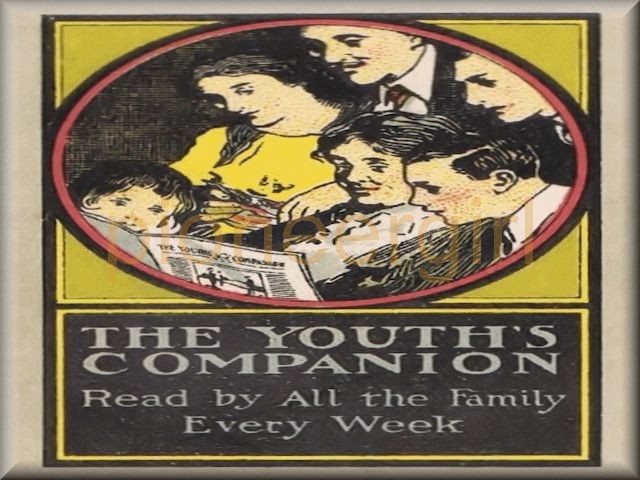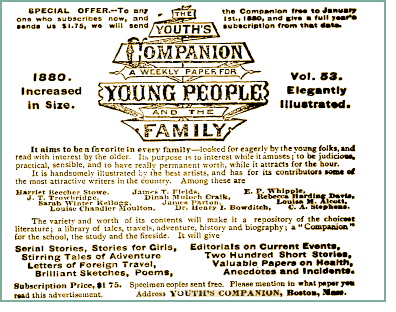The Youth’s Companion

Youth’s Companion was first published in Boston in 1827 as a weekly instructional magazine for children. Its editors, Nathaniel Willis and Asa Rand, created the publication to encourage religious virtue and piety in children. In 1929, it merged with American Boy, and ceased to be a separate publication.
The first issue of Youth’s Companion outlined its purpose:
 The capacities of children, and the peculiar situation and duties of youth, require select and appropriate reading. And while adults have various periodical publications, which they consider highly valuable, the younger part of the community seem to require that the same means be prepared for their gratification. If to these we add one reason more, the propriety of the step we have taken will be apparent. This is a day of peculiar care of Youth. Christians feel that their children must be trained up for Christ. Patriots and philanthropists are making rapid improvements in every branch of education. Literature, science, liberty and religion are extending in the earth. The human mind is becoming emancipated from the bondage of ignorance and superstition. Our children are born to higher destinies than their fathers. Let their minds be formed, their hearts prepared, and their characters molded for the scenes and the duties of a brighter day. The contents of the proposed work will be miscellaneous, though articles of a religious character will be most numerous. It will not take the form of discussion, or argument, and controversy will be entirely excluded. It will aim to inculcate truth by brief narratives, familiar illustrations, short biographies, and amusing anecdotes.
The capacities of children, and the peculiar situation and duties of youth, require select and appropriate reading. And while adults have various periodical publications, which they consider highly valuable, the younger part of the community seem to require that the same means be prepared for their gratification. If to these we add one reason more, the propriety of the step we have taken will be apparent. This is a day of peculiar care of Youth. Christians feel that their children must be trained up for Christ. Patriots and philanthropists are making rapid improvements in every branch of education. Literature, science, liberty and religion are extending in the earth. The human mind is becoming emancipated from the bondage of ignorance and superstition. Our children are born to higher destinies than their fathers. Let their minds be formed, their hearts prepared, and their characters molded for the scenes and the duties of a brighter day. The contents of the proposed work will be miscellaneous, though articles of a religious character will be most numerous. It will not take the form of discussion, or argument, and controversy will be entirely excluded. It will aim to inculcate truth by brief narratives, familiar illustrations, short biographies, and amusing anecdotes.
Although Laura Ingalls Wilder refers to the publication as Youth’s Companion in the Little House books, the name had been change to The Youth’s Companion in 1841. It was often simply referred to as “The Companion.”
At the time the Ingalls girls were reading it in the 1880s, it was still a religious instructional paper, but was fast becoming more entertaining, with special sections for household articles, health and hygiene, popular science articles, games and puzzles, and a charming children’s page. During the Little House years, the editor was Daniel S. Ford; The Youth’s Companion was then published by Perry Mason & Co., in Boston. One of Ford’s methods of increasing circulation was to offer premiums for subscriptions. Children canvassed friends and neighbors and could earn everything from pencil cases to pianos by selling subscriptions. As circulation increased, The Youth’s Companion attracted notable contributors, including Louisa May Alcott, Emily Dickinson, Mark Twain, Helen Keller, and Theodore Roosevelt.
In The Long Winter, Wilder implies that the Ingallses do not subscribe to The Youth’s Companion – that they receive bundles of copies forwarded by children in Reverend Alden’s church in Minnesota. As the above advertisement from 1879 shows, an annual subscription was $1.75, and it remained at that rate for well over a decade.
In 1929, The Youth’s Companion merged with American Boy, and ceased to be a separate publication. Originally a Boy Scout magazine, American Boy ceased publication in 1941.
An issue of The Youth’s Companion.
To read an entire issue of The Youth’s Companion (photographs of my personal copy), click on the linked pages below. The Youth’s Companion was printed as a single sheet, front and back, and folded to make eight pages. The mailing address was printed on the side of the first page. By cutting the fold at the top of the cover page, the pages could be turned like a typical magazine, and were numbered in sequence. Pages began with “1” at the beginning of a calendar year, and were numbered consecutively throughout the year. The featured issue is dated August 5, 1875, which was the month Freddy Ingalls was born; the first page of the issue is 245. This issue features the short story titled “Old Major,” written by Louisa May Alcott.

The Youth’s Companion (TLW 18; LTP 18; THGY 16)









